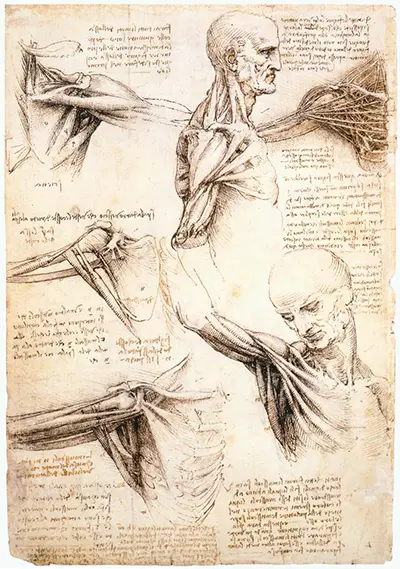This work, which was created using ink on paper, is typical of the High Renaissance interest not just in artistic flourishing but also scientific discoveries of all kinds.
Anatomical Studies of the Shoulder is part of a large body of anatomical work created by da Vinci. His other anatomical studies include detailed depictions of the way in which the muscles move in the neck and studies of babies developing in the womb.
Anatomical Studies of the Shoulder is sometimes referred to as 'Anatomical Studies of the Male Shoulder', to reflect the type of cadaver that Leonardo was using as his model.
There was a certain degree of distaste and disapproval about artists and anatomists using cadavers for experiments, but the practice got more and more widespread throughout the Renaissance.
The page of da Vinci's notebooks on which Anatomical Studies of the Shoulder is to be found contains several depictions of a shoulder, from various different angles. At some points, we see how the anatomy of the shoulder fits in to the entire anatomy of the upper body.
At other points, da Vinci zooms in to the shoulder and explores in details certain muscles and tendons.
Anatomical Studies of the Shoulder is not just a set of images, however: it is an integrated piece, which involves both anatomical sketches and explanatory text in da Vinci's handwriting (which often took the form of 'mirror writing').
This is also characteristic of other of da Vinci's anatomical drawings.
Several art critics have done some interesting work attempting to match up anatomical studies such as Anatomical Studies of the Shoulder with Leonardo's oil paintings.
There is definitely a link to be made between his interest in the composition of the human body beneath the skin and the way in which he painted the play of light on the skin, and realistic, emotion filled facial expressions.
Anatomical Studies of the Shoulder shows that da Vinci was particularly interested in tendons and musculature. Like many Renaissance artists, anatomy theatres provided him with inspiration for questions about the relationship between the mind and body, and for an understanding of movement, strength and volition.
Perhaps the most famous painting on this topic, which is an interesting point of comparison with Anatomical Studies of the Shoulder, is Rembrandt's painting called The Anatomy Lesson.
Though it was painted over a century after Anatomical Studies of the Shoulder, Rembrandt's depiction of an anatomy lesson in oil paintings demonstrates that da Vinci was not the only Renaissance artist to see the huge creative potential that could be unleashed from the intersection between art and medicine.
The human form appears in both disciplines, and both help viewers to see it in a unique manner.



